Spring: A Manic Time in the Garden
The Season’s Ups and Downs
To me, spring can be a manic time of year. On the one hand, no tree is more beautiful or festive than a peach tree loaded with pink blossoms. I’d say almost the same for apples, pears, and plums, their branches laden with clusters of white blossoms.
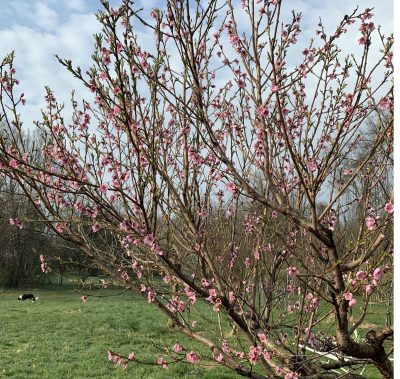
And it’s such a hopeful season. If all goes well, those blossoms will morph, in coming months, into such delicacies as Hudson’s Golden Gem and Pitmaston Pineapple apples, and Magness, Seckel, and Concorde pears. My peach tree was grown from seed, so has no name. With all this beauty and anticipation, I can periodically forget the pandemic that’s raging beyond my little world here.
But even as my eyes feast on the scene and I forget about the pandemic, I can’t forget about the weather’s ups and downs. Specifically, the temperature: Frosty weather has the potential to turn blossoms to mush and ruin the chances for fruit. Especially on my farmden, here in the Wallkill River valley. As in other low-lying locations, on clear, cold nights, a temperature inversion occurs, with heat radiated to the clear sky making ground level temperatures low. Cold air is denser than warmer air, so all the cold air flows down slopes to collect in valleys.
There’s not much to do to avert that frost damage. A blanket thrown over a tree would help but my trees are too large and too many. Branches could be sprayed with water; water, in transitioning to ice, releases its heat of fusion as long as it’s continuously applied. A helicopter or a “wind machine” could dilute colder air at ground level with warmer air from higher up. These methods might be used commercially but, to quote the sage of Newburgh (that’s another story), “That’s not gonna happen” here.
Therapy, a Plan
Rather than worrying myself into the manic phase of spring, I’m going to assess the damage and live with it. For starters, I need to know the temperature.
I have been using is a nifty little device called Sensorpush, a 1-inch square cube, perhaps a half-inch thick, that I have mounted outside and that continually transmits the temperature to my cell phone.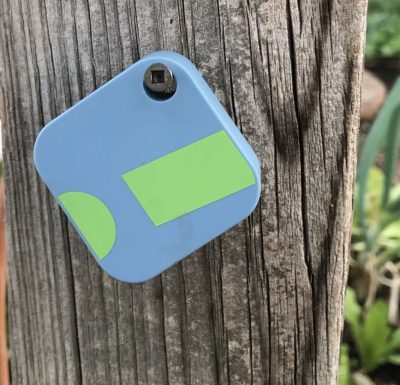 Great. Even better, temperature (as well as humidity) is recorded, and can be displayed graphically or downloaded to my computer. So I didn’t have to be awake to find out the mercury hit 32.5°F at 12:16 AM on the night of April 17th and stayed there until it began rising around 7 AM.
Great. Even better, temperature (as well as humidity) is recorded, and can be displayed graphically or downloaded to my computer. So I didn’t have to be awake to find out the mercury hit 32.5°F at 12:16 AM on the night of April 17th and stayed there until it began rising around 7 AM.
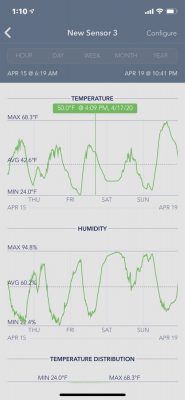
Fortunately, researchers have compiled temperatures at which damage to blossoms occurs. Specifically, damage enough to wipe 10% of the crop, and damage enough to wipe out 90% of the crop. And more specifically, applying those numbers to various kinds of fruits, which vary in their blossom’s cold tolerances. And even more specifically to the various stages of blossoming for each kind of fruit. Generally, less cold is required to kill a blossom the closer it is to bloom time.
Here is a chart compiled and photographed by Mark Longstroth of Michigan State University:

So now I can take this information, couple it with data recorded by Sensorpush, and foretell my sensory future, pomologically speaking. Below freezing temperatures since trees awakened have been 24° on April 17th, 27° on April 19th, and 26° on April 21st. Of course, it ain’t over till it’s over, and the average date of the last frost here is about mid-May.
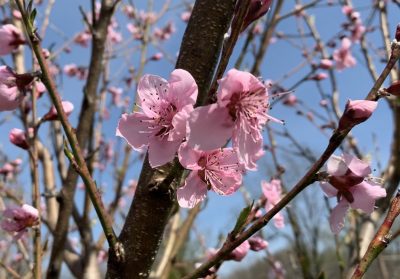
Peach bloom
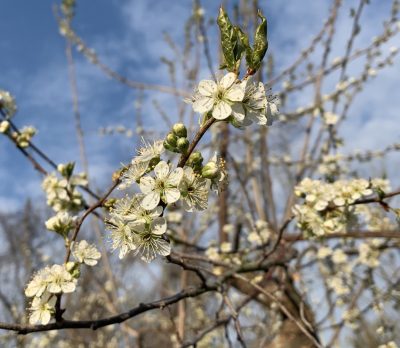
Plum blossoms
My plum trees were in full bloom on April 13th, at which time the blossoms are susceptible to 10% kill at 28° and 90% kill at 23°. That makes only 10% loss. The peach tree was also in bloom on that date, and is very similar in it’s blossom’s cold tolerance, so only 10% loss there also, so far.
Asian pears were showing “first white” and “full white” on April 19th, when the low hit 27°. That temperature would cause them no damage. The same would be true, going forward, for subsequent temperatures above 27°. The Europeans should be fine because today, April 21st, they are in tight cluster, and cold hardy to 24°.
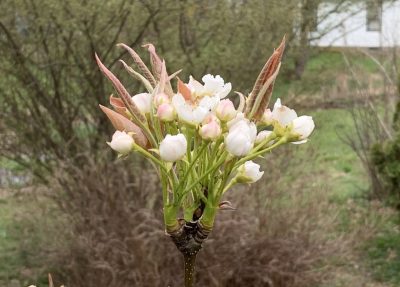
Asian pear full white
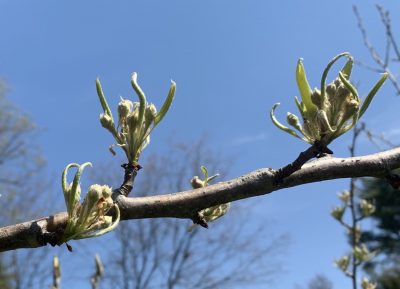
European pear tight cluster
Apples also are fine, also in tight cluster so, according to the chart, undamaged by temperatures above 27°.

Apple blossom tight cluster
And a Sprinkle of the Unknown
All this seems very science-y comforting, and it is. As with most garden science, though, things are more complicated, to some extent, than can be easily predicted. For one thing, some variation in cold hardiness undoubtedly exists from one variety to the next. In the case of my trees, I have an American hybrid and some European hybrid plums; they might more generally differ in blossom hardiness. And what about the length of time at a given temperature, and the effect of humidity?
Overall, the chart has calmed me down. Not to mention that a certain amount of fruit loss would be a good thing. A tree has just so much energy, and too big a crop makes for less flavor and size. Only 5% of blossoms of an apple tree need to set fruit for a full crop.
Now, I can move on to worry about insect and diseases that might hone in on my fruit.

